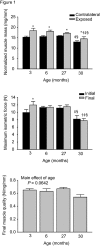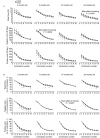Age-dependent Muscle Adaptation after Chronic Stretch-shortening Contractions in Rats
- PMID: 26816659
- PMCID: PMC4723229
- DOI: 10.14336/AD.2015.0920
Age-dependent Muscle Adaptation after Chronic Stretch-shortening Contractions in Rats
Abstract
Age-related differences in contraction-induced adaptation have been well characterized especially for young and old rodent models but much less so at intermediate ages. Therefore, additional research is warranted to determine to what extent alterations in adaptation are due to maturation versus aging per se. The purpose of our study was to evaluate muscles of Fisher 344XBrown Norway rats of various ages following one month of exposure to stretch-shortening contractions (SSCs). With exposure, muscles mass increased by ~10% for 27 and 30 month old rats vs. ~20% for 3 and 6 month old rats (P < 0.05). For 3 month old rats, maximum isometric force and dynamic peak force increased by 22 ± 8% and 27 ± 10%, respectively (P < 0.05). For 6 month old rats, these forces were unaltered by exposure and positive work capacity diminished by 27 ± 2% (P = 0.006). By 30 months of age, age-related deficits in maximum isometric force, peak force, negative work, and positive work were apparent and SSC exposure was ineffective at counteracting such deficits. Recovery from fatigue was also tested and exposure-induced improvements in fatigue recovery were indicated for 6 month old rats and to a lesser extent for 3 month old rats whereas no such effect was observed for older rats. Alterations in fatigue recovery were accompanied by evidence of substantial type IIb to IIx fiber type shifting. These results highlight the exceptional adaptive capacity for strength at a young age, the inclination for adaptation in fatigue recovery at early adulthood, and diminished adaptation for muscle performance in general beginning at late adulthood. Such findings motivate careful investigation to determine appropriate SSC exposures at all stages of life.
Keywords: Fisher 344XBrown Norway rats; dorsiflexor muscles; dynamometer; repetitive exposure.
Figures






Similar articles
-
High-intensity stretch-shortening contraction training modifies responsivity of skeletal muscle in old male rats.Exp Gerontol. 2018 Apr;104:118-126. doi: 10.1016/j.exger.2018.02.009. Epub 2018 Feb 10. Exp Gerontol. 2018. PMID: 29438735
-
Agonist muscle adaptation accompanied by antagonist muscle atrophy in the hindlimb of mice following stretch-shortening contraction training.BMC Musculoskelet Disord. 2017 Feb 2;18(1):60. doi: 10.1186/s12891-017-1397-4. BMC Musculoskelet Disord. 2017. PMID: 28148306 Free PMC article.
-
The influence of velocity of stretch-shortening contractions on muscle performance during chronic exposure: age effects.Appl Physiol Nutr Metab. 2007 Jun;32(3):443-53. doi: 10.1139/H07-014. Appl Physiol Nutr Metab. 2007. PMID: 17510679
-
The stretch-shortening cycle : a model to study naturally occurring neuromuscular fatigue.Sports Med. 2006;36(11):977-99. doi: 10.2165/00007256-200636110-00004. Sports Med. 2006. PMID: 17052133 Review.
-
Muscle mechanics: adaptations with exercise-training.Exerc Sport Sci Rev. 1996;24:427-73. Exerc Sport Sci Rev. 1996. PMID: 8744258 Review.
Cited by
-
Enhancement of Skeletal Muscle in Aged Rats Following High-Intensity Stretch-Shortening Contraction Training.Rejuvenation Res. 2017 Apr;20(2):93-102. doi: 10.1089/rej.2016.1816. Epub 2016 Aug 3. Rejuvenation Res. 2017. PMID: 27378453 Free PMC article.
-
Adaptability to eccentric exercise training is diminished with age in female mice.J Appl Physiol (1985). 2023 Nov 1;135(5):1135-1145. doi: 10.1152/japplphysiol.00428.2023. Epub 2023 Oct 12. J Appl Physiol (1985). 2023. PMID: 37823203 Free PMC article.
-
Elevated muscle mass accompanied by transcriptional and nuclear alterations several months following cessation of resistance-type training in rats.Physiol Rep. 2022 Oct;10(20):e15476. doi: 10.14814/phy2.15476. Physiol Rep. 2022. PMID: 36259109 Free PMC article.
-
The Relationship between Resistance Training Frequency and Muscle Quality in Adolescents.Int J Environ Res Public Health. 2022 Jul 1;19(13):8099. doi: 10.3390/ijerph19138099. Int J Environ Res Public Health. 2022. PMID: 35805760 Free PMC article.
-
Immunoengineering Biomaterials for Musculoskeletal Tissue Repair across Lifespan.Adv Mater. 2024 Jul;36(28):e2311646. doi: 10.1002/adma.202311646. Epub 2024 May 7. Adv Mater. 2024. PMID: 38416061 Free PMC article. Review.
References
-
- Lauretani F,Russo CR,Bandinelli S,Bartali B,Cavazzini C,Di Iorio A, et al. (2003). Age-associated changes in skeletal muscles and their effect on mobility: an operational diagnosis of sarcopenia. Journal of applied physiology, 95: 1851-1860 - PubMed
-
- Baker BA,Cutlip RG (2010). Skeletal muscle injury versus adaptation with aging: novel insights on perplexing paradigms. Exercise and sport sciences reviews, 38: 10-16 - PubMed
-
- Greig CA,Gray C,Rankin D,Young A,Mann V,Noble B, et al. (2011). Blunting of adaptive responses to resistance exercise training in women over 75y. Experimental gerontology, 46: 884-890 - PubMed
LinkOut - more resources
Full Text Sources
Other Literature Sources
